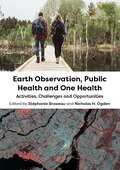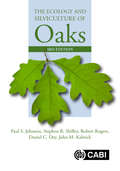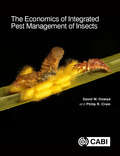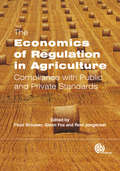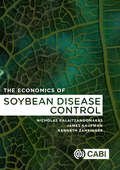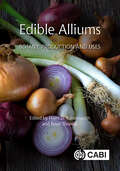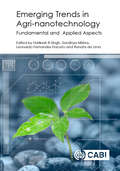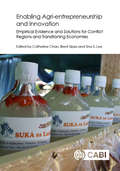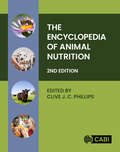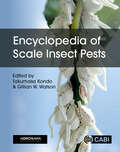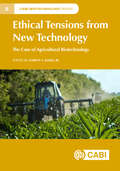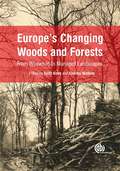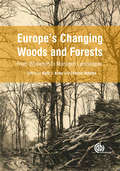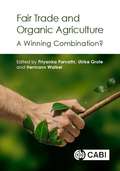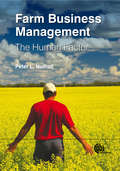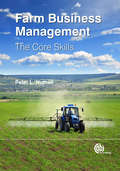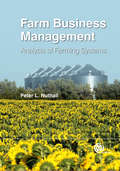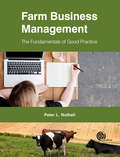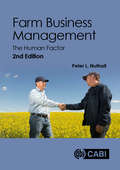- Table View
- List View
Earth Observation, Public Health and One Health: Activities, Challenges and Opportunities
by Brazeau Stéphanie Nicholas H. OgdenThis book reviews the contributions of Earth Observation (EO) to public health practices. It examines how EO is being used to understand, track, predict, and manage infectious and chronic diseases, and it provides discussion on the current challenges and the significant development potential of EO to a One Health approach. Its objective is to address a set of questions: How does EO currently assist public health activities? What are the challenges for operational use of EO in public health? What are the opportunities for EO to benefit public health in the near future? This review concentrates on the following priority themes to which EO and geomatics can make important contributions: mosquito-borne and tick-borne diseases; water-borne diseases; air quality and extreme heat effects; and geospatial indicators of vulnerable human populations. EO has also demonstrated potential during the COVID-19 pandemic as an efficient provider of data on rapid environmental and socio-economic changes and impacts. Remotely sensed data are particularly useful for risk modelling and mapping projects to help generate information on occurrence and spatio-temporal trends of disease risk. Similarly, EO can be used to identify risk factors for disease risk or emergence detected in surveillance, and support development of early warning systems. Risk maps enable public health professionals to anticipate and prepare for health threats, and they can support responses to infectious disease epidemics or existing endemic conditions. This book emerged from the collaboration of the Public Health Agency of Canada and the Canadian Space Agency with contributions of international experts. Their findings will be of great value to public health and EO professionals interested in developing and applying geospatial applications in the risk assessment and management of public health issues.
The Ecology and Silviculture of Oaks (Cabi Publishing Ser.)
by Paul Johnson Stephen Shifley Robert Rogers Daniel C. Dey John M KabrickThe third edition of The Ecology and Silviculture of Oaks is an updated and expanded edition that explores oak forests as responsive ecosystems. New chapters emphasize the importance of fire in sustaining and managing oak forests, the effects of a changing climate, and advanced artificial regeneration techniques. This new edition expands on silvicultural methods for restoring and sustaining oak woodlands and savannahs, and on management of ecosystem services, including wildlife habitat. It also incorporates new material on evaluating landscape-scale, and cumulative effects of management action compared with inaction. Nine of the fifteen chapters cover updated information on the geographic distribution of US oaks, oak regeneration dynamics, site productivity, stocking and stand development, even- and uneven-aged silvicultural methods, and growth and yield. This edition includes a new section with colour illustrations for improved visualization of complex relationships. This book is intended for forest and wildlife managers, ecologists, silviculturists, environmentalists, and students of those fields.
The Ecology and Silviculture of Oaks (Cabi Publishing Ser.)
by Paul Johnson Stephen Shifley Robert Rogers Daniel C. Dey John M KabrickThe third edition of The Ecology and Silviculture of Oaks is an updated and expanded edition that explores oak forests as responsive ecosystems. New chapters emphasize the importance of fire in sustaining and managing oak forests, the effects of a changing climate, and advanced artificial regeneration techniques. This new edition expands on silvicultural methods for restoring and sustaining oak woodlands and savannahs, and on management of ecosystem services, including wildlife habitat. It also incorporates new material on evaluating landscape-scale, and cumulative effects of management action compared with inaction. Nine of the fifteen chapters cover updated information on the geographic distribution of US oaks, oak regeneration dynamics, site productivity, stocking and stand development, even- and uneven-aged silvicultural methods, and growth and yield. This edition includes a new section with colour illustrations for improved visualization of complex relationships. This book is intended for forest and wildlife managers, ecologists, silviculturists, environmentalists, and students of those fields.
The Economics of Integrated Pest Management of Insects
by Jeffrey Alwang Zachary S. Brown Adeney De Bueno Peter C Ellsworth Bruna Magda Favetti George B Frisvold Yara A. Halasa-Rappel Erin W. Hodgson Menale Kassie John Mumford Rangaswamy Muniappan Steven E. Naranjo George W Norton Roderick Rejesus Donald S. ShepherdMany biological studies on insect management do not consider economics or fundamental economic principles. This book brings together economists and entomologists to explain the principles, successes, and challenges of effective insect management. It highlights the importance of economic analyses for decision making and the feasibility of such approaches, and examines integrated pest management (IPM) practices from around the world with an emphasis on agriculture and public health. The book begins by establishing an economic framework upon which to apply the principles of IPM. It continues to examine the entomological applications of economics, specifically, economic analyses concerning chemical, biological, and genetic control tactics as well as host plant resistance and the cost of sampling and is illustrated with case studies of economic-based IPM programs from around the world.
Economics of Regulation in Agriculture
by Consuelo Varela-Ortega Roel Jongeneel Floor Brouwer Alfons Weersink Jon Winsten Glenn Fox Anton Meister Irina Bezlepkina Vicki Swales Silvia De Miranda Kaley Hart Kees De RoestThis work debates and investigates the cross-compliance system - whereby farmers comply with certain standards relating to the environment, food safety and animal and plant health. It discusses cross-compliance in the context of existing standards, on-farm costs and the competitiveness of farm businesses. Analysing the economics of regulation both within the internal market of the EU and the broader world market by examining a broad range of agricultural products. This resource will be of value to agriculture and resource economists, policy makers, researchers and students in environmental and agricultural policy and modelling.
The Economics of Soybean Disease Control
by Nicholas Kalaitzandonakes James Kaufman Kenneth ZahringerWorldwide soybean crop yields can achieve USD$130 billion per year in farm-level sales, but around 13% of these yields are lost to disease. Effective disease management could generate significant economic benefits, and while disease management strategies do exist, their application remains limited among producers, often due to an incomplete understanding of disease incidence and severity, as well as perceived complexities of these strategies and a lack of information regarding success rates. This book presents an economic perspective on disease control, with an emphasis on producer choice among alternative technologies and potential changes in cropping systems. It provides an overview of global soybean diseases, their economic significance and management, and covers farm-level decision making, economic payoffs of alternative disease practices and key uncertainties. The book also outlines a global economic model that evaluates disease distribution and management implications. Key features include: - Extensive empirical case studies of soybean disease control, offering strategies for economically optimal management of diseases such as soybean seedling disease and root rot. - Analysis of economic factors to guide farm-level decision making. - Consideration of new technologies in disease management and their potential market-level impacts. This text is recommended for students and researchers in plant pathology and agricultural economics, as well as professionals in the soybean production industry.
The Economics of Soybean Disease Control
by Nicholas Kalaitzandonakes James Kaufman Kenneth ZahringerWorldwide soybean crop yields can achieve USD$130 billion per year in farm-level sales, but around 13% of these yields are lost to disease. Effective disease management could generate significant economic benefits, and while disease management strategies do exist, their application remains limited among producers, often due to an incomplete understanding of disease incidence and severity, as well as perceived complexities of these strategies and a lack of information regarding success rates. This book presents an economic perspective on disease control, with an emphasis on producer choice among alternative technologies and potential changes in cropping systems. It provides an overview of global soybean diseases, their economic significance and management, and covers farm-level decision making, economic payoffs of alternative disease practices and key uncertainties. The book also outlines a global economic model that evaluates disease distribution and management implications. Key features include: - Extensive empirical case studies of soybean disease control, offering strategies for economically optimal management of diseases such as soybean seedling disease and root rot. - Analysis of economic factors to guide farm-level decision making. - Consideration of new technologies in disease management and their potential market-level impacts. This text is recommended for students and researchers in plant pathology and agricultural economics, as well as professionals in the soybean production industry.
Edible Alliums: Botany, Production and Uses (Botany, Production and Uses)
by Haim D. Rabinowitch Brian ThomasAllium crops include more than 30 species, many of which (for e.g. onions, shallots, garlic, leeks, bunching onions, and chives) are of economic importance. Bulb onions rank second only to tomatoes in terms of global production. Alliums are farmed and harvested in a range of climatic conditions worldwide, forming important parts of local diets. This book provides a comprehensive review of major and minor Allium crops from scientific and horticultural perspectives. It broadly covers modern biology (including genetics and breeding), propagation, production, processing, and nutritional and health benefits. Edible Alliums contains coverage of: Both major and minor Allium crops. Improving crop production, quality, and sustainability of Allium crops. Advances in digital technologies, 'omics' research and gene editing. Objectives for improving crop performance, such as integrated crop management, the plant-soil interface, improving propagation materials, post-harvest quality and reducing waste. This is an essential resource for scholars, researchers and students in plant science and agriculture, in addition to molecular biologists, plant breeders, agronomists, consultants, and extension specialists.
Emerging Trends in Agri-nanotechnology: Fundamental And Applied Aspects
by Harikesh B. Singh Sandhya Mishra Leonardo Fernandes Fraceto Renata De LimaThe science of nanotechnology, the manipulation, design and engineering of devices at the atomic and molecular scale, is starting to be applied to many disciplines including aspects of agriculture and crop science. This book opens with a brief history of nanotechnology in agriculture. Applications are then examined in detail, including nanopesticides, nanosensors, nanofertilizers, and nanoherbicides. Topics covered include; the biosynthesis of nanoparticles (through microbes, plants and other biotic agents); the ecological consequences of their delivery into the environment (examining effects and toxicity on soil, soil biota, and plants); safety issues; an overview of the global market for nanotechnology products, and the regulation of nanotechnology in agriculture. The book concludes with speculations on what the future holds for the technology. The book has been written by an international group of researchers and experts from over 12 countries with experience across a wide range of issues relating to the industry. This book will be of use to a wide range of researchers and professional scientists in the agricultural sector, academia and industry, including microbiologists, chemical engineers, geneticists, plant scientists and biochemists.
Emerging Trends in Agri-Nanotechnology: Fundamental and Applied Aspects
by Amina Antonacci Marcelo Dutra Arbo Fabiana Arduini Daiana Silva Avila Carolina Castro Bueno Estefania V Campos R K Chaturvedi Deepika Chauhan Manoj Kumar Chitara Sampa Das Jhones L Oliveira Dr Renata De Lima Kunzes Dolma Carolina Alves Santos Professor Leonardo Fernandes Fraceto Aniket Gade Solange Cristina Garcia Renato Grillo Kelvii Wei Kelvii Wei Indarchand Gupta Janmejay Pandey Mauricio Tavares Jacques Akansha Jain Gagan Kumar Anupam Maharshi S Marimuthu Sandhya Mishra Vijay Kumar Mishra Arpan Mukherjee Jessica Nardi Semih Otles Raksha Pandit Jai Singh Patel Mahendra Rai K Raja Rahul Singh Rajput Ratul Moni Ram Indira Rathore Buket Yalcin Sahyar Dr Birinchi Sarma Viviana Scognamiglio Harikesh Bahadur Singh Jyoti Singh N N Singh Prachi Singh Surendra Singh Amira S Soliman Ankit Srivastava Arohi Srivastava K S Subramanian J C Tarafdar Sudheer K Yadav Xiaodong YangThe science of nanotechnology, the manipulation, design and engineering of devices at the atomic and molecular scale, is starting to be applied to many disciplines including aspects of agriculture and crop science. This book opens with a brief history of nanotechnology in agriculture. Applications are then examined in detail, including nanopesticides, nanosensors, nanofertilizers, and nanoherbicides. Topics covered include; the biosynthesis of nanoparticles (through microbes, plants and other biotic agents); the ecological consequences of their delivery into the environment (examining effects and toxicity on soil, soil biota, and plants); safety issues; an overview of the global market for nanotechnology products, and the regulation of nanotechnology in agriculture. The book concludes with speculations on what the future holds for the technology. The book has been written by an international group of researchers and experts from over 12 countries with experience across a wide range of issues relating to the industry. This book will be of use to a wide range of researchers and professional scientists in the agricultural sector, academia and industry, including microbiologists, chemical engineers, geneticists, plant scientists and biochemists.
Enabling Agri-entrepreneurship and Innovation
by Catherine Chan Brent Sipes Tina S. LeeAgricultural entrepreneurs in conflict and post-conflict regions face special challenges; not just everyday personal risks, but also the difficulties of building small businesses when real or threatened violence can disrupt business growth cycles and economic security. Alongside establishing secure institutions, building a secure economy is rightly seen as the best way for conflict-torn regions to establish a peaceful future. But current agricultural entrepreneurship training and development starts from an assumption of peace, meaning that it is not always fit for purpose. The result is sub-optimal program design and inefficient use of resources. A product of a collaboration of experts in the fields of agri-business, agricultural marketing, and international development, this book gives officials and agencies developing entrepreneurship programs the practical real-life examples they need. Key Features: #65533; Based on research by experienced field practitioners. #65533; Establishes best practice approaches for supporting agri-entrepreneurship in conflict regions. #65533; Range of global case studies to illustrate lessons learnt.
Enabling Agri-entrepreneurship and Innovation: Empirical Evidence and Solutions for Conflict Regions and Transitioning Economies
by Anera Alishani Jovelyn Bantilan Emilie Bayona Maurizio Canavari Domenico Dentoni Ekrem Gjokaj Muje Gjonbalaj Jacqueline Jacqueline James R. Hollyer Drini Imami Cynthia Lai Kathleen Liang Rusyan Jill Mamiit Lusille Mission Elma Neyra Michelle Ragocos Ortez Bikash Bikash Mary M. Pleasant Klodjan Rama Pauline Sullivan Bir Bahadur Tamang Katherine A. Wilson Edvin ZhllimaAgricultural entrepreneurs in conflict and post-conflict regions face special challenges; not just everyday personal risks, but also the difficulties of building small businesses when real or threatened violence can disrupt business growth cycles and economic security. Alongside establishing secure institutions, building a secure economy is rightly seen as the best way for conflict-torn regions to establish a peaceful future. But current agricultural entrepreneurship training and development starts from an assumption of peace, meaning that it is not always fit for purpose. The result is sub-optimal program design and inefficient use of resources. A product of a collaboration of experts in the fields of agri-business, agricultural marketing, and international development, this book gives officials and agencies developing entrepreneurship programs the practical real-life examples they need. Key Features: · Based on research by experienced field practitioners. · Establishes best practice approaches for supporting agri-entrepreneurship in conflict regions. · Range of global case studies to illustrate lessons learnt.
The Encyclopedia of Animal Nutrition
by C.J.C. PhillipsThe Encyclopedia of Animal Nutrition covers animal nutrition across a wide range of disciplines, including physiology, biochemistry, veterinary medicine and feed technology. Through approximately 3000 entries ranging from short definitions to more discursive articles, it discusses and illuminates on all aspects of this important topic. The book: - Covers every type of animal managed in developing and developed countries, from livestock and companion animals to those commonly found in laboratories and zoos; - Includes human nutrition as well as fish species used in aquaculture, and farmed invertebrates such as honey bees and prawns, and animals of localised significance such as yaks, snakes, crocodiles, and asses; - Addresses important societal topics in relation to nutrition, including welfare, environmental pollution, disease, resource use, and animal product quality. Written by a global team of contributors and expert section editors, this book is an important resource for researchers, students and advisers of animal nutrition and feed, as well as anyone interested in agriculture, the food industry, veterinary science, zoology, physiology, human health, animal science, and animal behaviour.
Encyclopedia of Scale Insect Pests
by Jocelyn A. Berry Manuela Branco Lyle Buss Mr Alejandro Caballero Mr Juang Horng Chong Lucía E. Claps C. De Klerk Rodrigo Diaz Imre Foldi Antonio P. Garonna Ilya A. Gavrilov-Zimin Jan H. Giliomee Raymond J. Gill Penny J. Gullan Disna N. Gunawardana Helen Harman Sunil Joshi M. Bora Kaydan Paris L. Lambdin Yen-Po Lin Christopher Malumphy Zvi Mendel Vitor Cezar Pacheco da Silva Giuseppina Pellizzari Ana Lúcia Peronti Francesco Porcelli Alex Protasov Ting-Kui Qin Andrea Amalia Ramos Portilla Dewi Sartiami Scott A. Schneider U.G.A.I. Sirisena Pompeo Suma Éva Szita Hirotaka TanakaScale insects feed on plant juices and can easily be transported to new countries on live plants. They sometimes become invasive pests, costing billions of dollars in damage to crops worldwide annually, and farmers try to control them with toxic pesticides, risking environmental damage. Fortunately, scale insects are highly susceptible to control by natural enemies so biological control is possible. They have unique genetic systems, unusual metamorphosis, a broad spectrum of essential symbionts, and some are sources of commercial products like red dyes, shellac and wax. There is, therefore, wide interest in these unusual, destructive, beneficial, and abundant insects. The Encyclopedia of Scale Insect Pests is the most comprehensive work on worldwide scale insect pests, providing detailed coverage of the most important species (230 species in 26 families, 36% of the scale insect pest species known). Advice is provided on collection, preservation, slide-mounting, vouchering, and labelling of specimens, fully illustrated with colour photographs, diagrams and drawings. Pest species are presented in two informal groups of families, the 'primitive' Archaeococcoids followed by the more 'advanced' Neococcoids, covered in phylogenetic order. Each family is illustrated and diagnosed based on features of live and slide-mounted specimens, with information on numbers of genera and species, main hosts, distribution, and biology. For the important pest species, coverage includes information on the morphology of live and slide-mounted specimens, common names, principal synonyms, geographical distribution, plant hosts, plant damage and economic impact, reproductive biology, dispersal, and management strategies including biological, cultural and chemical control, sterile insect techniques, regulatory control, early warning systems and field monitoring. An additional complete list of scale insect pests worldwide is provided, comprising 642 species in 28 scale insect families (about 8% of the 8373 species of living scales known), with information on plant hosts, geographical distribution and validation sources. Beneficial uses of scale insects include sources of red dyes, natural resins and waxes, and agents for invasive weed control, alongside the importance of their honeydew to bees for making honey, and as a food source to other animals. Academic researchers, students, entomologists, pest management officials in agribusiness or government including plant quarantine identifiers, extensionists, farmers, field scientists and ecologists will all benefit from this book.
Ethical Tensions from New Technology: The Case Of Agricultural Biotechnology (Plant Science / Horticulture Ser. #6)
by Harvey S. James Jr.The introduction of new technologies can be controversial, especially when they create ethical tensions as well as winners and losers among stakeholders and interest groups. While ethical tensions resulting from the genetic modification of crops and plants and their supportive gene technologies have been apparent for decades, persistent challenges remain. This book explores the contemporary nature, type, extent and implications of ethical tensions resulting from agricultural biotechnology specifically and technology generally. There are four main arenas of ethical tensions: public opinion, policy and regulation, technology as solutions to problems, and older versus new technologies. Contributions focus on one or more of these arenas by identifying the ethical tensions technology creates and articulating emerging fault lines and, where possible, viable solutions.
Europe's Changing Woods and Forests
by Diego Moreno Chris Quine Xavier Rochel Jim Latham Juha Siitonen Tibor Hartel Emma Goldberg Peter Buckley Thomas Ranius John Fletcher Per Anglestam Matthias Bürgi Tomasz Samojlik George Peterken Robert Robert Charles Watkins Peter Savill Keith Kirby Roberta Cevasco Robert Hearn Martin Hermy Clive PotterOur understanding of the ecological history of European forests has been transformed in the last twenty years. Bringing together key findings from across the continent, this book provides a comprehensive account of the relevance of historical studies to current conservation and management of forests. It combines theory with a series of regional case studies to show how different aspects of forestry play out according to the landscape and historical context of the local area.
Europe's Changing Woods and Forests: From Wildwood to Managed Landscapes
by Tibor Hartel Thomas Ranius Peter Buckley Peter Savill Chris Quine Matthias Bürgi John Fletcher Robert Hearn Martin Hermy Diego Moreno Tomasz Samojlik George Peterken Xavier Rochel Per Anglestam Jim Latham Emma Goldberg Roberta Cevasco Clive Potter Juha Siitonen Robert RobertOur understanding of the historical ecology of European forests has been transformed in the last twenty years. Bringing together key findings from across the continent, Europe's Changing Woods and Forests: From Wildwood to Managed Landscapes provides a comprehensive account of recent research and the relevance of historical studies to our current conservation and management of forests. Combining theory with a series of regional case studies, this book shows how different aspects of forestry play out according to the landscape and historical context of the local area, with broad implications for woodland history, policy and management. Beginning with an overview of Europe's woods and forests, the book reviews a variety of management techniques (including wood-pastures, coppicing, close-to-nature forestry and the impact of hunting), describes how plants and animals respond to changes in woodland and forest cover, and includes case histories from around the continent. It concludes with a discussion of how lessons learned from the past can help in the future. This book is both a vital resource and an interesting read for foresters, conservationists, landscape historians, geographers and ecologists.
Fair Trade and Organic Agriculture
by Priyanka Parvathi Ulrike Grote Hermann WaibelThe markets for organic and fair trade certified commodities are growing rapidly, with environmentally sound and more equitable certification systems likely to offer benefits for both small-scale farmers and society at large. Despite much debate about their contribution to sustainability, there has been little scientific analysis, so it is vital to assess if it is technically and economically feasible to meet growing consumer demands regarding food safety, quality and ethics through smallholder and marginal producers. Overall, there is a need to explore the potential of these certification systems as emerging areas in research and development cooperation. This book includes: - Worldwide case studies (from the supply side in Asia, Africa, and Latin America; and from the demand side in Europe and North America) to put theory into practice. - Analyses of sustainable development and poverty reduction through organic and fair trade markets. - Insights into the conditions where it is beneficial for developing country smallholder producers to adopt fair trade and organic certification systems. - Investigation into whether consumers will pay more for a product that is both organic and fair trade certified. This book is an important read for researchers and students in agricultural and development economics, and it is also a useful resource for policy makers and practitioners involved in organic and fair trade agriculture.
Fair Trade and Organic Agriculture: A Winning Combination?
by Arnab Basu Lee Buyers Rene Capote Ricardo Fort Professor Ulrike Grote Casey Goldvale Ulrich Hamm Pradyot Ranjan Jena Linda Kleemann Katharina Krumbiegel Julia Lernoud Dr Priyanka Parvathi Yu Hui Qiao Ruerd Ruben Rosa Scheenbecker Till Stellmacher Romane Viennet Professor Hermann Waibel Helga Willer Meike Wollni Katrin ZanderThe markets for organic and fair trade certified commodities are growing rapidly, with environmentally sound and more equitable certification systems likely to offer benefits for both small-scale farmers and society at large. Despite much debate about their contribution to sustainability, there has been little scientific analysis, so it is vital to assess if it is technically and economically feasible to meet growing consumer demands regarding food safety, quality and ethics through smallholder and marginal producers. Overall, there is a need to explore the potential of these certification systems as emerging areas in research and development cooperation. This book includes: - Worldwide case studies (from the supply side in Asia, Africa, and Latin America; and from the demand side in Europe and North America) to put theory into practice. - Analyses of sustainable development and poverty reduction through organic and fair trade markets. - Insights into the conditions where it is beneficial for developing country smallholder producers to adopt fair trade and organic certification systems. - Investigation into whether consumers will pay more for a product that is both organic and fair trade certified. This book is an important read for researchers and students in agricultural and development economics, and it is also a useful resource for policy makers and practitioners involved in organic and fair trade agriculture.
Farm Business Management
by Peter NuthallThe underlying economic factors that effect primary production are frequently studied and written about - soil quality, animal health, climate, machinery - but this is the first book to explore the role of the psychology of the manager running the farm business, the person responsible for staff, strategic decisions and financial success or failure. The book will address fundamental questions such as the process of decision making, personal skills, and methods to improve managerial ability. It is an essential reference for farm managers and students in farm economics and management.
Farm Business Management
by Michael Thompson Patrick Skelly Peter NuthallBased on research carried out within the farming community and academic studies, this book assesses and explains the core skills needed to become a successful farm manager. Observation, anticipation of plan outcomes, and risk management are identified as key requirements, and each of these categories is broken down into isolated skills such as problem definition and visual observation, which are in turn dissected and analysed. Practical methods for acquiring or improving each skill are covered in detail, with practice exercises to engage the reader in active participation. This book is an essential resource for farm managers and students.
Farm Business Management
by Professor Peter L NuthallThe third and final instalment of Peter Nuthall's Farm Business Management series, this volume teaches the practical skills needed to manage a farm, such as risk analysis, budgeting, cost benefit analyses and much more. The key characteristic of this book is its ability to simplify the complex subject of business management into a clear, accessible volume tailored to the topic of farming, by using engaging techniques such as worked examples to fully explain the complex decision making tools necessary for this discipline.
Farm Business Management: The Fundamentals of Good Practice
by Peter NuthallFarming is a complex job with many unique challenges, but can also be a rich and rewarding career that is full of opportunities. Following the author's Farm Business Management series, this new textbook takes the core principles and techniques and distils them into an accessible student resource. This book: covers the most important aspects of farm management, such as observation, decision making, budgeting, risk assessment and record keeping; is organized into easy-to-navigate sections such as the farmer's environment, financials, key skills and farm systems; and includes student-focused pedagogy throughout, comprising learning objectives, focus study exercises and review questions. Written by an expert with decades of teaching and research experience around the world, this book also incorporates two brand new chapters on farm accounting and computer systems and software. Providing a hands-on learning experience for students of agriculture, it will continue to be a much-used resource throughout their farming career. This book is enhanced with supplementary resources. Read chapter 1, and access free questions, tasks and lecture slides here.
Farm Business Management: The Human Factor (Agriculture Ser.)
by Peter L. NuthallThe underlying economic factors that affect primary production are frequently studied and written about―soil quality, animal health, climate, machinery―but this is the first book to explore the role of the decision psychology of the manager running the farm business, the person responsible for staff, strategic and operational decisions and the success or failure of financial and other objective outcomes. This second edition addresses fundamental questions such as the process of decision making, personal skills, and methods to improve managerial ability. It is an essential reference for farm managers and students in farm economics and management.
Farm Business Management: The Fundamentals of Good Practice (Agriculture Ser.)
by Peter NuthallFarming is a complex job with many unique challenges, but can also be a rich and rewarding career that is full of opportunities. Following the author's Farm Business Management series, this new textbook takes the core principles and techniques and distils them into an accessible student resource. This book: covers the most important aspects of farm management, such as observation, decision making, budgeting, risk assessment and record keeping; is organized into easy-to-navigate sections such as the farmer's environment, financials, key skills and farm systems; and includes student-focused pedagogy throughout, comprising learning objectives, focus study exercises and review questions. Written by an expert with decades of teaching and research experience around the world, this book also incorporates two brand new chapters on farm accounting and computer systems and software. Providing a hands-on learning experience for students of agriculture, it will continue to be a much-used resource throughout their farming career. This book is enhanced with supplementary resources. Read chapter 1, and access free questions, tasks and lecture slides here.
